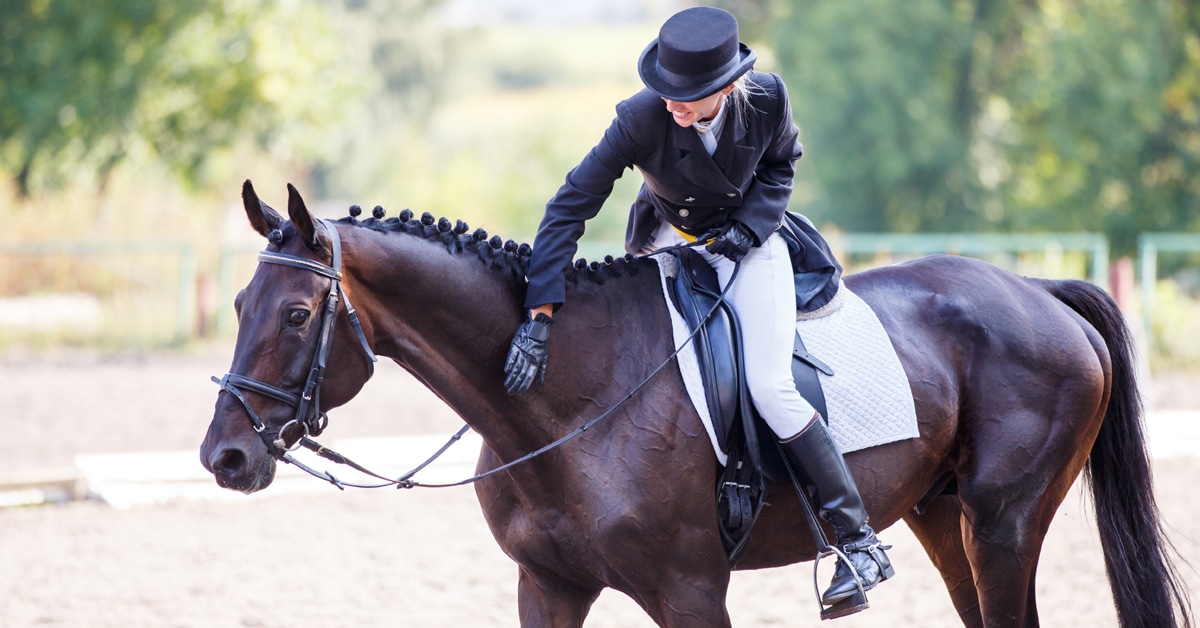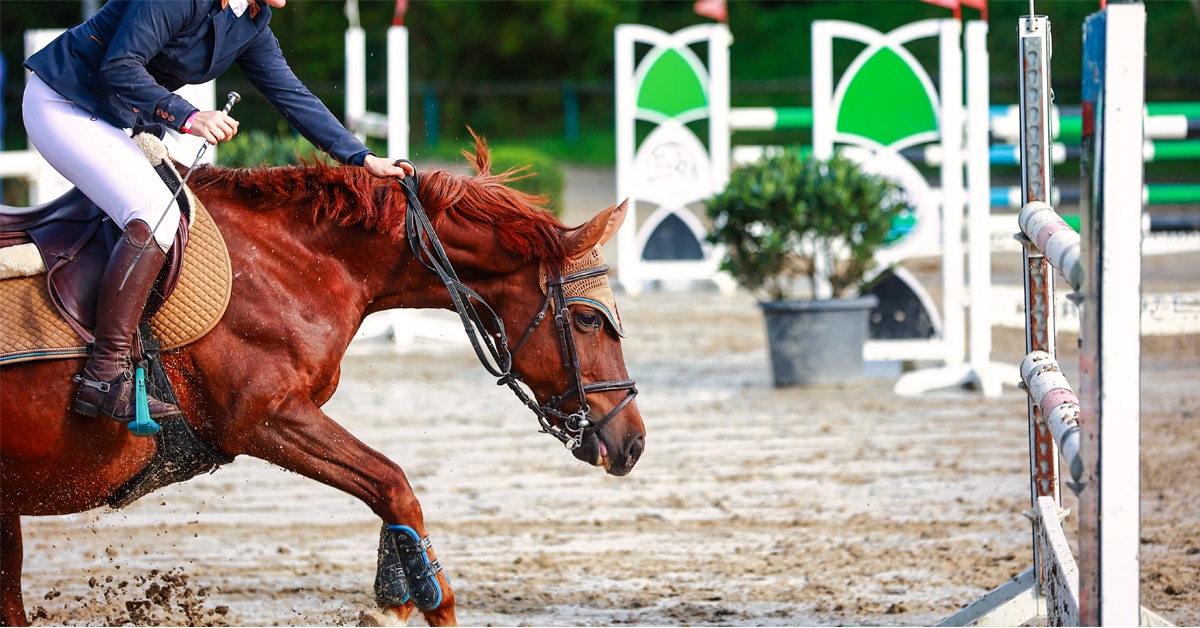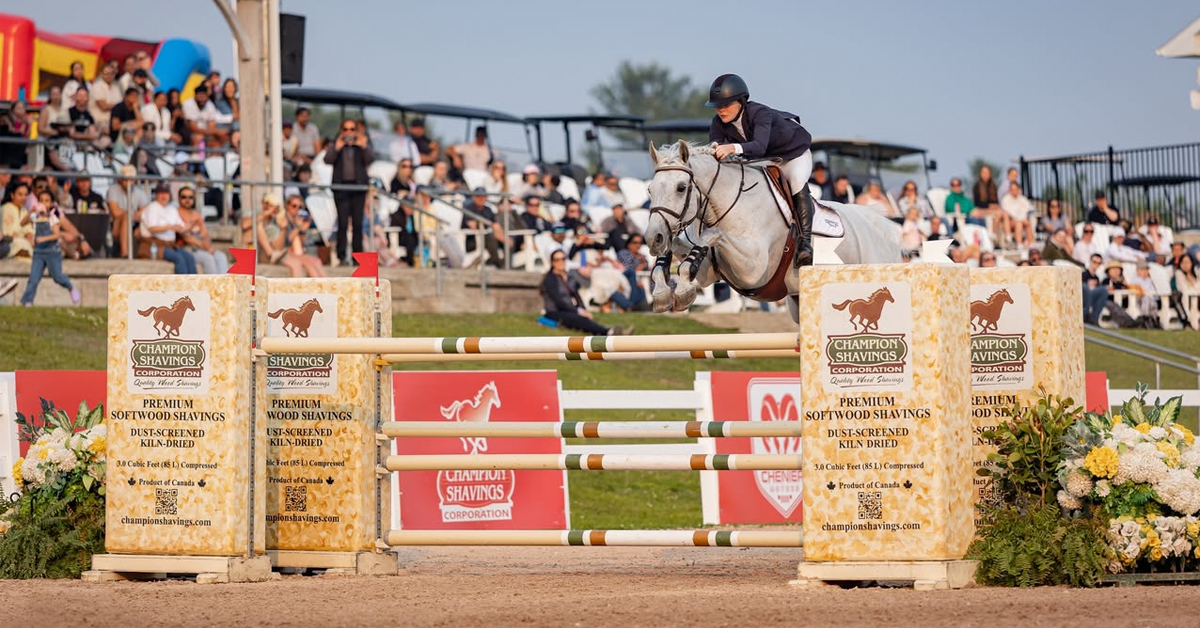If you’ve purchased a new helmet in the past couple of years, chances are you’re already aware of MIPS technology. If not, read on and we’ll explain what MIPS is and why it’s so important ‒ while busting a few helmet myths along the way.
What is MIPS?
MIPS stands for Multi-Directional Impact Protection System, and that’s exactly what it is – a design technology that allows helmets to provide more protection to the wearer in the case of an impact or fall. While MIPS has been widely used in sports such as cycling, downhill skiing, and snowboarding for years, it’s a relatively new addition to equestrian helmets.
How does it work?
During an angled impact, rotational motion causes damage to the brain, often resulting in a concussion or more serious TBI (traumatic brain injury). The MIPS magic lies in a thin layer of plastic added to the inside of a helmet. This low-friction layer, as it’s called, is designed to move inside the helmet shell to provide a shearing effect. The MIPS layer can slide 10 to 15mm relative to the helmet shell in all directions, dissipating the impact energy away from a direct blow to the skull, thereby reducing brain damage.
Traditional helmets are designed to protect the skull in the case of a linear impact – a fall straight down onto the head. The hard helmet shell is tested for its ability to withstand an impact and prevent a rock or other hard object from penetrating that shell and reaching the skull. However, they are not designed to prevent the forces generated by a fall or impact from being absorbed by the brain, nor are they tested for performance when the impact is on an angle – a much more realistic simulation of a fall from a horse.
By dispersing some of that energy away from the brain, the MIPS low-friction layer reduces the likelihood and the severity of a brain injury, providing significantly more protection to the rider.
Watch is excellent short video about how MIPS works HERE.
Why is it so important?
As much as we love our sport and our equine partners, their very size and speed make them potentially dangerous. The height and the speed from which you fall are significant risk factors for TBI and the risk increases with each impact to the head and neck. A 2016 study published in Neurological Focus revealed that equestrian sports accounted for 45.2% of all sports-related TBIs in adults, the highest percentage of all sports examined.
To learn more about the importance of MIPS, we reached out to Robert Leeder, president of Phoenix Performance Products. Based near Toronto, this Canadian company is the industry’s leading manufacturer of protective equipment for equestrian sports, including the Tipperary line of vests and helmets. Tipperary launched its first MIPS helmet, the Windsor, in the spring of 2020, with plans for more models to come.
“Our Windsor sales have been through the roof,” says Leeder. “We are constantly producing to meet demand. Rider feedback has been really positive about everything from the fit to the style, and that’s one of the things we love about MIPS; riders don’t even know it’s there. It doesn’t add bulk or change the helmet fit or comfort in any way.
“There are for or five different technologies that have been adapted for high-risk sports, and all aim to do essentially the same thing – dissipate the energy that comes in contact with the skull to reduce the force on the brain,” he continues. “We looked at them all but decided to go with MIPS because of the incredible amount of science behind it – more than 20 years of research and testing.
“It’s no different than wearing a seat belt in the car,” he adds. “Why wouldn’t you want the best protection possible when you ride? Every consumer should be considering MIPS for themselves or their family members. The science is clear; if the helmet and your head can’t move in opposite directions during an impact, 100% of the forces absorbed by the helmet goes to your head. If you can redirect some of that energy away, lessen the severity of the impact and reduce the risk of a brain injury, why wouldn’t you?”
He concludes, “Safety is paramount, but we know style and fashion play a big role in helmet choice. Our goal at Tipperary has always been to build a helmet that’s as safe as we can possibly make it, to ensure it fits really well, and to make it look as good as any expensive helmet on the shelf. Nobody should have to sacrifice style for safety.”
Does MIPS replace ASTM/SEI certification?
The short answer? No. To achieve SEI approval, all North American helmets designed for equestrian sport must meet the ASTM F1163 standard. Certification involves not just rigorous testing of the helmet’s ability to withstand an impact, but also inspections of manufacturing facilities and auditing of all the materials used to produce the various components of the helmet.
However, the ASTM test does have its limitations. The impact test is a linear drop onto a hard surface – an impact that simulates a rider falling straight down and landing on their head. Unfortunately, that’s rarely how falls happen in equestrian sports, and impacts are far more likely to be on an angle. Incorporating MIPS technology into an ASTM certified helmet adds another layer of protection.
True or False
We asked Leeder to address the three most common misconceptions about helmet safety:
1. Safety features make expensive helmets worth the splurge.
FALSE: When it comes to helmets, price point has nothing to do with protection. “All North American helmets have to pass the same ASTM standard, and they all offer basic protection, regardless of price. The difference between the inexpensive and the high-end models is simply style, fashion, and personal preference,” says Leeder.
In fact, an independent test of 15 helmet models conducted by a Swedish insurance company in 2018 showed not only that the models with MIPS outperformed traditional helmets, the one rated “best in test” was priced below average. All of the MIPS models currently available in Canada retail for between $380 and $430.
Folksam’s test of equestrian helmets show major differences in the levels of protection
2. Any well-fitted helmet offers as much protection as one with MIPS.
FALSE: “This is categorically false,” says Leeder. “Of course fit is of primary importance. A helmet must fit correctly or it won’t be as effective. But a properly fitted ASTM helmet with MIPS offers significantly more protection against brain injury than a standard ASTM helmet. With a number of MIPS models on the market now, there should be one to fit every rider.” He suggests that riders look for MIPS models that include a fit retention system, offering a few degrees of adjustability to ensure a perfect fit every ride.
3. European safety standards for helmets are superior to North American ones.
FALSE: “This misconception is dangerously false,” cautions Leeder. “There’s a reason ASTM / SEI certification is mandatory in North America. Common European certifications such as EN, CE, or VG simply don’t compare and don’t offer the same level of protection to riders. It’s a big risk to riders who are willing to accept lower safety standards, and an even bigger risk to any North American retailers who may be tempted to sell European models that don’t have ASTM certification; doing so may leave the retailer open to liability in case of a serious injury.”
Building a Better Helmet
Researchers continue to look for ways to make helmets even safer for athletes. Here in North America, three projects are currently underway.
Thanks to funding from the US Equestrian Federation, US Hunter Jumper Association and US Eventing Association, among others, researchers at the Virginia Tech Helmet Lab are working to create an equestrian-specific rating system which will give riders insight into how helmet models compare when it comes safety and protection.
“Having a Sport Specific Helmet Rating system (STAR) for the equestrian industry is crucial to the improved safety of all the riders,” says Dr. Barry Miller, director of Outreach and Business Development at the Virginia Tech Helmet Lab. “This rating will benefit the helmet industry to improve designs by providing real world concussion risk data and parameters for testing in order to reduce concussion risks and of course inform riders of the relative differences between helmets as it relates to concussion risks.”
The initial research has already begun, and results and ratings are expected to be released in November, 2022.
At the University of Kentucky, students are working to develop a helmet testing method and collect data that will hopefully serve as the start of a crushing-safety standard for equestrian helmets. Crushing accidents, while rare, occur when the rider falls from the horse and the horse either steps on or falls on top of the rider’s head. While equestrian helmets certified according to ASTM standards protect riders in a variety of ways, there is no test in place to evaluate a helmet’s crush resistance.
The students received a project award from ASTM International and began by researching the frequency and severity of equestrian crushing accidents, designing a headform to fit into a helmet for testing, and developing sensors to record lateral forces applied to the headform. Project advisor Stephanie Bonin, who is also chair of the ASTM Equestrian Helmet Committee, said, “Helmet standards need to rely on both field and laboratory test data. In order to develop a compression test protocol and acceptance criteria, we need to test helmets at load rates that represent crushing scenarios in the field while recording headform forces. The headform forces will be compared to published injury tolerance data.”
The students will present the results of their project at the end of the current semester and submit a final report to ASTM.
And finally, at the College of Engineering and Applied Sciences at Western Michigan University in Kalamazoo, MI, a new sensor cap designed for helmet wearers is providing feedback that can help improve fit and hopefully lead to better diagnostics and treatment when riders fall. Similar to a ‘pressure mat’ worn under the saddle to detect uneven pressure, the cap includes 16 pressure sensors that provide a “map” of pressure across the head under the helmet. The cap provides data about the force and direction of impact, the location on the head, and even the head position at impact, which can help medical personnel administering treatment.
The cap might also useful in tack shops to help people select helmets, or for parents to monitor fit as children grow.
The Latest











